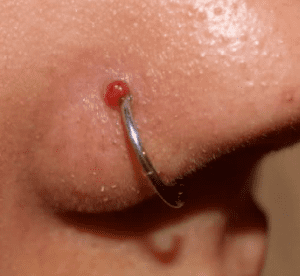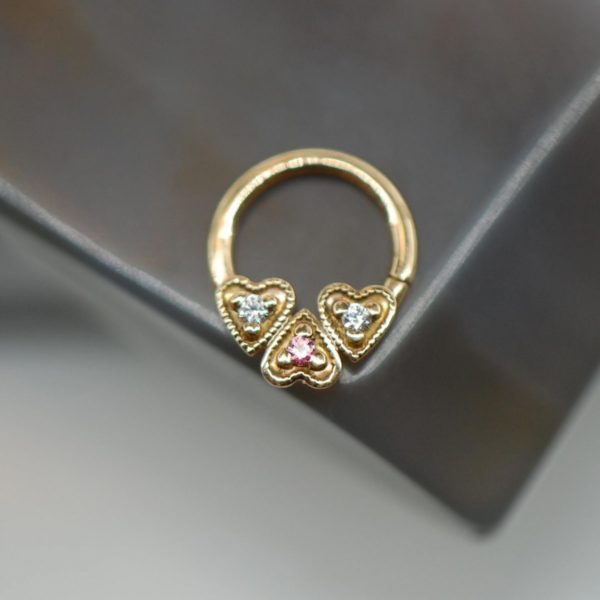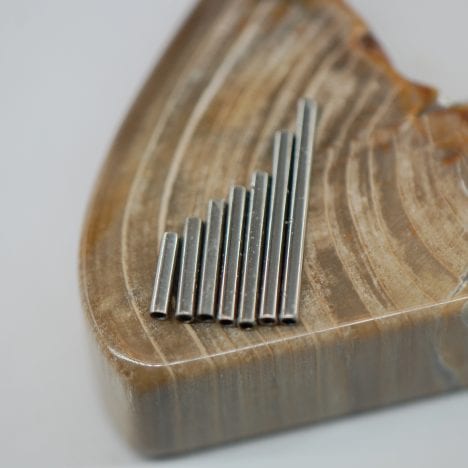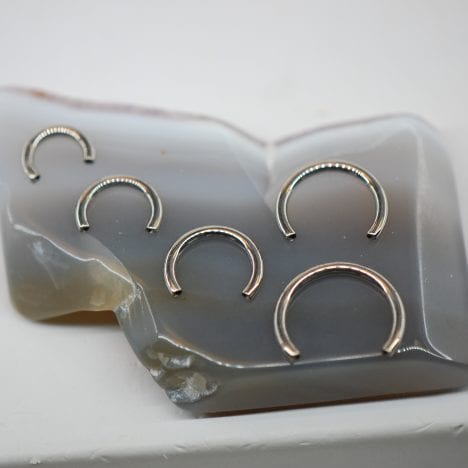“I’ve heard tea tree oil is like, really great for your piercings!” This is something we here all too often here at Amato, and so we’ve decided to write a little article here to debunk the myth of tea tree oil! Tea Tree Oil is a natural oil derived from the Australian tree Melaleuca Alternifolia. It’s sometimes confused with the same tea used to make drinks and brew, but the two are unrelated. Tea Tree Oil is known for a distinctive smell, it’s pale yellow color, and its anti fungal, anti bacterial, and astringent properties. It’s all the rage right now in beauty products, from tea tree oil shampoos for oily hair, to spot treatments for adult acne. It’s also been a popular homeopathic trend for body piercing for many years. The only problem is, its actually not safe! Not only is there NO conclusive evidence about the safety of tea tree oil on any topical use, there is strong evidence to support its detriment on puncture wounds- which is exactly what a body piercing is!
But I heard this will fix my bump?! I have this ugly bump on my piercing and my friend/the internet said this will fix it” This is the statement we hear the most, and it’s full of misinformation. To start, lets brake this statement down. You have a bump or some form of irritation on your piercing, and you want to get rid of it, so you are looking for help. Your first step with this should be to contact your piercer! Too many people look to their friends or the internet for advice, when there are trained and skilled professionals here to help. Reaching out to your local reputable piercer should be your first step. After all, if you had chicken pox you wouldn’t ask your friend- you’d see a doctor! If your car had a flat- you’d see your mechanic! See your piercer.
The second flaw here is the actual thought that tea tree oil will ‘fix’ the bump on a piercing. What happens more often then not is the tea tree oil dries out the skin, and the bump temporarily seems to be getting smaller. However, without the actual cause of the bump being fixed, it will always come back. Bumps on piercings can happen for a range of reasons, from hitting or sleeping on them, from low quality jewelry, or poorly done piercings. If your piercing was done incorrectly, or you jewelry is made from low quality, no amount of mystery oils will fix that- you aren’t treating the problem, just the symptom! And if its just from being snagged or slept on some time and patience will help the bump go down. This is why seeing a piercer is so important. They can help determine the cause of the bump, and also the best way to get it to go away.

But its natural, doesn’t that make it safe?
Not at all! Peanuts are natural too, but some people have severe and serious allergies to it. Something being natural does not mean its safe. Tea Tree oil, while considered “safe” for topical use only, is actually never to be ingested. It becomes toxic when you do, and the American Cancer Society reports you can experience drowsiness and confusion. They have reported hallucinations, rashes, vomiting, and even comas from tea tree oil. Now, many of these things occur because dosage for tea tree oil is generally unclear. Undiluted, pure tea tree oil is what you usually find for sale in the herbal section of your local grocery store or health market, and that concentration is far too strong to be using directly on a wound, or to get in your mouth or nose. Piercers aren’t doctors, and also usually don’t have a background with essential oils to try to explain dosing to their clients. Not to mention- clients don’t often know much about it either! Beyond the dose and concentration, purchasing essential oils is it’s own beast. The market is loosely regulated, and it’s not uncommon to find different chemicals in these ‘essential oils’ you see for sale on the walmart end cap. This leaves many people trying different strengths or doses, or just looking at random websites or around the internet trying to figure out how to use it. Not ideal.
The problem is compounded because many people think “it’s just my body piercing- that’s just topical so I’ll try it!” Not so. While some people may be safe to use tea tree oil or a scrape or scratch, a piercing is a puncture wound. It’s an entirely different type of wound that heals differently and requires different care. A puncture wound can become clogged with topical products like tea tree oil, and it can severely dry our the fragile healing tissue around the wound. Not to mention most often we see clients using tea tree oil on ear and nostril piercings. On your ears, you may not realize the oil has gotten in or around your ear canal which can be harmful- middle ear toxicity has been reported due to tea tree oil. We see clients with irritated daith or tragus piercings who end up getting TTO in the ear canal trying to apply it to those hard to reach and see irritations.Your nostril is a mucous membrane, and can absorb the tea tree oil similarly to ingesting, and cause the same toxic side effects.
A 2009 article from the American Cancer Society reviews the possible uses of tea tree oil as an antiseptic for minor cuts and scrapes, however primary addresses that “despite years of use, available clinical evidence does not support the effectiveness of tea tree oil for treating skin problems and infections in humans.” Russell J, Rovere A, eds. (2009). “Tea Tree Oil”. American Cancer Society Complete Guide to Complementary and Alternative Cancer Therapies (2nd ed.). American Cancer Society. ISBN 9780944235713.
And, in 2012 a study done in relation to head lice in children looked at tea tree oil as a treatment for kids but recommended against it because of the risk of allergic reactions, skin irritations, because of contradictions in the research, and because of just a general lack of understanding about the oils safety and effectiveness. Most concerning was evidence that when gotten into the middle ear, it can cause toxicity of the ear! You don’t want that on or near your ear piercings.
Eisenhower, Christine; Farrington, Elizabeth Anne (2012). “Advancements in the Treatment of Head Lice in Pediatrics”. Journal of Pediatric Health Care. 26 (6): 451–61; quiz 462–4.
In a study for Tea Tree Oil vs Benzol Peroxide in the treatment of acne while TTO did help improve the acne, it vastly under performed the BP.
“One of the first rigorous clinical studies assessed the efficacy of 5% TTO in the treatment of acne by comparing it to 5% benzoyl peroxide (BP) The study found that both treatments reduced the numbers of inflamed lesions, although BP performed significantly better than TTO. The BP group showed significantly less oiliness than the TTO group. “
A comparative study of tea-tree oil versus benzoylperoxide in the treatment of acne.
Bassett IB, Pannowitz DL, Barnetson RS
Med J Aust. 1990 Oct 15; 153(8):455-8.
So, can I put this on my piercing?
No! Listen, we don’t dispute that tea tree oil can perform well for acne, or that theirs a medical foundation to using it for anti fungal purposes (namely athletes foot- https://www.ncbi.nlm.nih.gov/pubmed/12121393/) that doesn’t mean it belongs on your body piercing!While there is a great premise in this product for other uses, it’s toxicity when ingested or absorbed into deeper wounds is very concerning with body piercings. Not to mention it’s risk of causing harm via your nostrils or your ear canal. Beyond that, The U.S. Food and Drug Administration does not strictly regulate herbs and supplements. There is no guarantee of strength, purity or safety of products, and effects may vary. In many studies and medical applications highly controlled, purified forms of tea tree oil were used- that’s not what’s on the market for the layperson to purchase. In fact, much like we talk abut mystery metals in body piercing, there’s plenty of mystery oils out there on the market for purchase. The lack of regulations, lack of studies regarding piercing, and known dangers around this product make it a thoroughly bad idea to put on any body piercing. Leave tea tree oil as the latest beauty fad, and work with your piercer to have happy and successful piercings.
(1)- Russell J, Rovere A, eds. (2009). “Tea Tree Oil”. American Cancer Society Complete Guide to Complementary and Alternative Cancer Therapies (2nd ed.). American Cancer Society. ISBN 9780944235713.
(2)- Eisenhower, Christine; Farrington, Elizabeth Anne (2012). “Advancements in the Treatment of Head Lice in Pediatrics”. Journal of Pediatric Health Care. 26 (6): 451–61; quiz 462–4.
(3)- A comparative study of tea-tree oil versus benzoylperoxide in the treatment of acne. Bassett IB, Pannowitz DL, Barnetson RS Med J Aust. 1990 Oct 15; 153(8):455-8.





